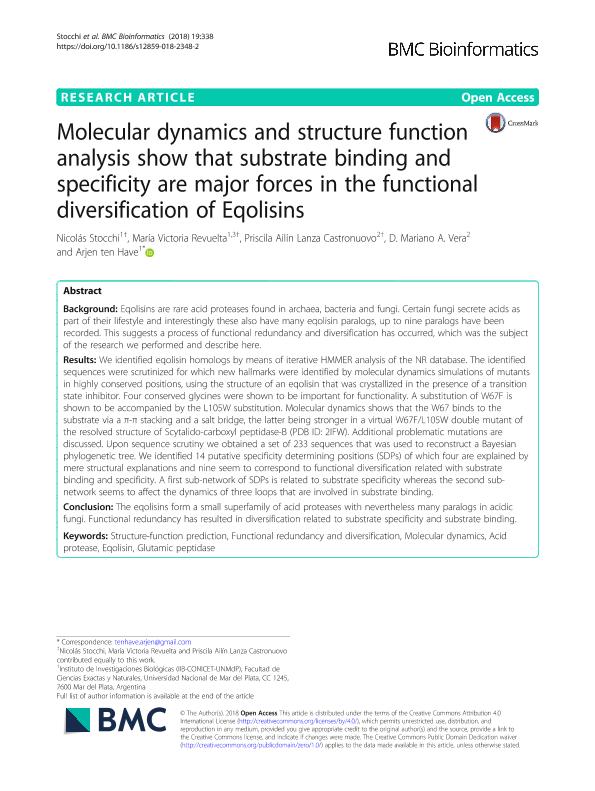Mostrar el registro sencillo del ítem
dc.contributor.author
Stocchi, Nicolas

dc.contributor.author
Revuelta, María Victoria

dc.contributor.author
Castronuovo, Priscila Ailín Lanza
dc.contributor.author
Vera, Domingo Mariano Adolfo

dc.contributor.author
Ten Have, Arjen

dc.date.available
2020-03-25T19:01:44Z
dc.date.issued
2018-09
dc.identifier.citation
Stocchi, Nicolas; Revuelta, María Victoria; Castronuovo, Priscila Ailín Lanza; Vera, Domingo Mariano Adolfo; Ten Have, Arjen; Molecular dynamics and structure function analysis show that substrate binding and specificity are major forces in the functional diversification of Eqolisins; BioMed Central; BMC Bioinformatics; 19; 1; 9-2018; 1-16
dc.identifier.issn
1471-2105
dc.identifier.uri
http://hdl.handle.net/11336/100764
dc.description.abstract
Eqolisins are rare acid proteases found in archaea, bacteria and fungi. Certain fungi secrete acids as part of their lifestyle and interestingly these also have many eqolisin paralogs, up to nine paralogs have been recorded. This suggests a process of functional redundancy and diversification has occurred, which was the subject of the research we performed and describe here. Results: We identified eqolisin homologs by means of iterative HMMER analysis of the NR database. The identified sequences were scrutinized for which new hallmarks were identified by molecular dynamics simulations of mutants in highly conserved positions, using the structure of an eqolisin that was crystallized in the presence of a transition state inhibitor. Four conserved glycines were shown to be important for functionality. A substitution of W67F is shown to be accompanied by the L105W substitution. Molecular dynamics shows that the W67 binds to the substrate via a π-π stacking and a salt bridge, the latter being stronger in a virtual W67F/L105W double mutant of the resolved structure of Scytalido-carboxyl peptidase-B (PDB ID: 2IFW). Additional problematic mutations are discussed. Upon sequence scrutiny we obtained a set of 233 sequences that was used to reconstruct a Bayesian phylogenetic tree. We identified 14 putative specificity determining positions (SDPs) of which four are explained by mere structural explanations and nine seem to correspond to functional diversification related with substrate binding and specificity. A first sub-network of SDPs is related to substrate specificity whereas the second sub-network seems to affect the dynamics of three loops that are involved in substrate binding. Conclusion: The eqolisins form a small superfamily of acid proteases with nevertheless many paralogs in acidic fungi. Functional redundancy has resulted in diversification related to substrate specificity and substrate binding.
dc.format
application/pdf
dc.language.iso
eng
dc.publisher
BioMed Central

dc.rights
info:eu-repo/semantics/openAccess
dc.rights.uri
https://creativecommons.org/licenses/by/2.5/ar/
dc.subject
ACID PROTEASE
dc.subject
EQOLISIN
dc.subject
FUNCTIONAL REDUNDANCY AND DIVERSIFICATION
dc.subject
GLUTAMIC PEPTIDASE
dc.subject
MOLECULAR DYNAMICS
dc.subject
STRUCTURE-FUNCTION PREDICTION
dc.subject.classification
Biología

dc.subject.classification
Ciencias Biológicas

dc.subject.classification
CIENCIAS NATURALES Y EXACTAS

dc.title
Molecular dynamics and structure function analysis show that substrate binding and specificity are major forces in the functional diversification of Eqolisins
dc.type
info:eu-repo/semantics/article
dc.type
info:ar-repo/semantics/artículo
dc.type
info:eu-repo/semantics/publishedVersion
dc.date.updated
2020-03-25T13:59:03Z
dc.journal.volume
19
dc.journal.number
1
dc.journal.pagination
1-16
dc.journal.pais
Reino Unido

dc.journal.ciudad
Londres
dc.description.fil
Fil: Stocchi, Nicolas. Consejo Nacional de Investigaciones Científicas y Técnicas. Centro Científico Tecnológico Conicet - Mar del Plata. Instituto de Investigaciones Biológicas. Universidad Nacional de Mar del Plata. Facultad de Ciencias Exactas y Naturales. Instituto de Investigaciones Biológicas; Argentina
dc.description.fil
Fil: Revuelta, María Victoria. Consejo Nacional de Investigaciones Científicas y Técnicas. Centro Científico Tecnológico Conicet - Mar del Plata. Instituto de Investigaciones Biológicas. Universidad Nacional de Mar del Plata. Facultad de Ciencias Exactas y Naturales. Instituto de Investigaciones Biológicas; Argentina
dc.description.fil
Fil: Castronuovo, Priscila Ailín Lanza. Consejo Nacional de Investigaciones Científicas y Técnicas. Centro Científico Tecnológico Conicet - Mar del Plata. Instituto de Investigaciones en Biodiversidad y Biotecnología; Argentina
dc.description.fil
Fil: Vera, Domingo Mariano Adolfo. Consejo Nacional de Investigaciones Científicas y Técnicas. Centro Científico Tecnológico Conicet - Mar del Plata. Instituto de Investigaciones en Biodiversidad y Biotecnología; Argentina
dc.description.fil
Fil: Ten Have, Arjen. Consejo Nacional de Investigaciones Científicas y Técnicas. Centro Científico Tecnológico Conicet - Mar del Plata. Instituto de Investigaciones Biológicas. Universidad Nacional de Mar del Plata. Facultad de Ciencias Exactas y Naturales. Instituto de Investigaciones Biológicas; Argentina
dc.journal.title
BMC Bioinformatics

dc.relation.alternativeid
info:eu-repo/semantics/altIdentifier/url/https://bmcbioinformatics.biomedcentral.com/articles/10.1186/s12859-018-2348-2
dc.relation.alternativeid
info:eu-repo/semantics/altIdentifier/doi/http://dx.doi.org/10.1186/s12859-018-2348-2
Archivos asociados
